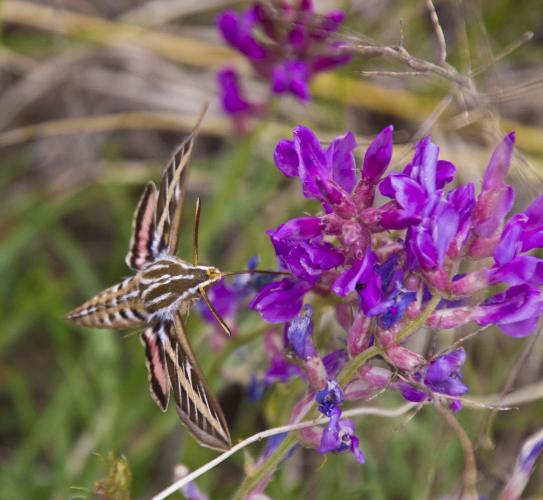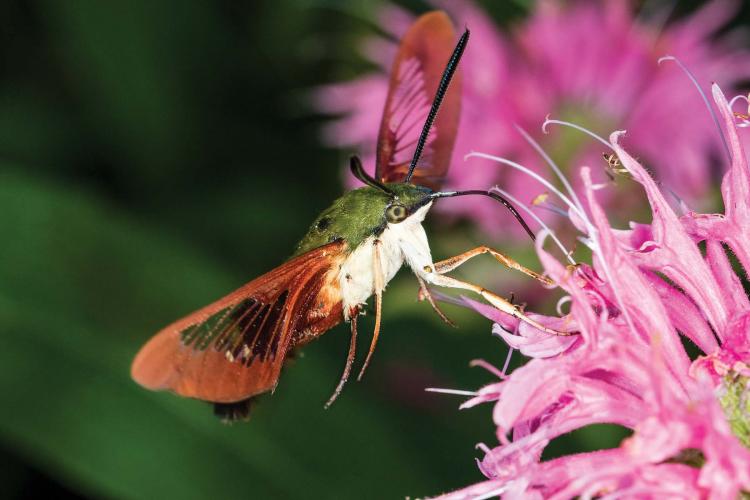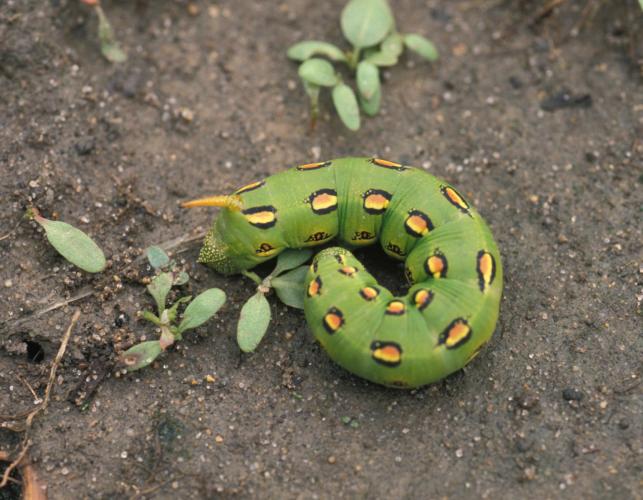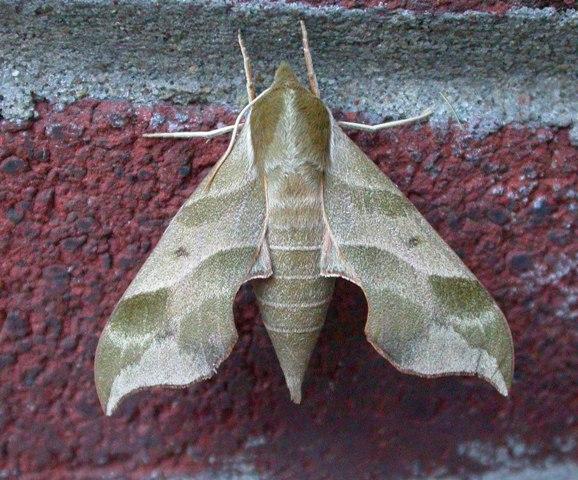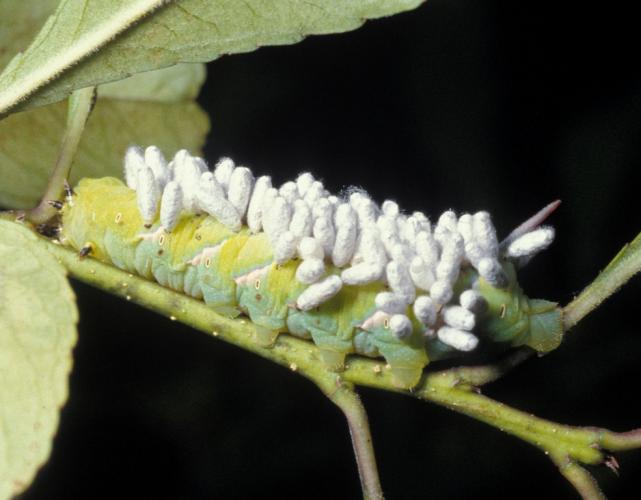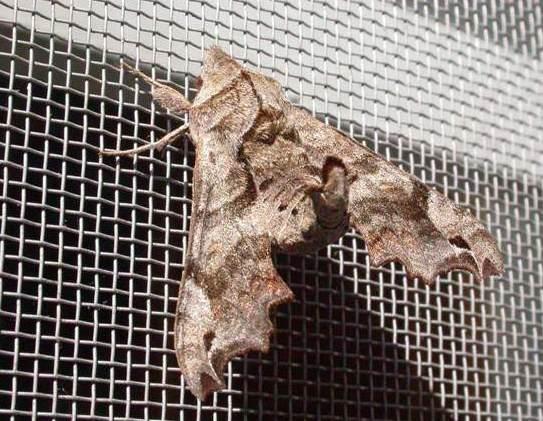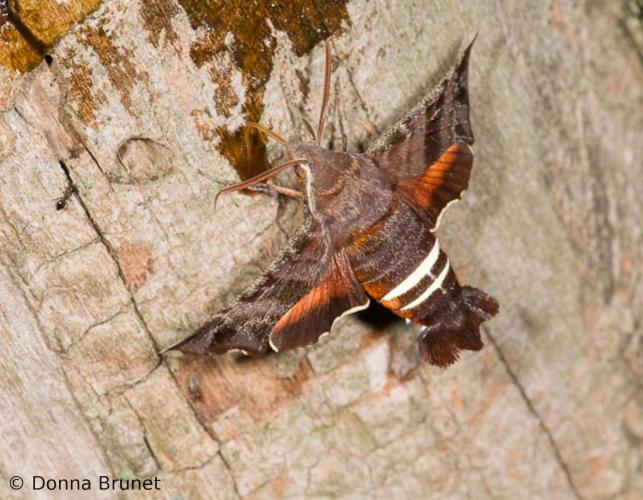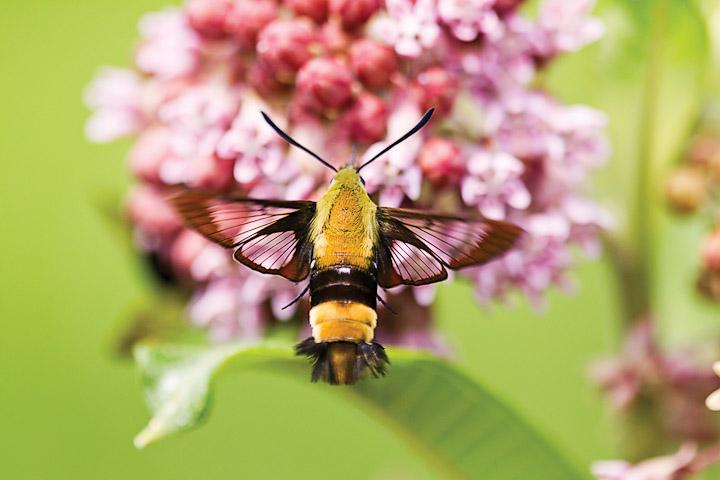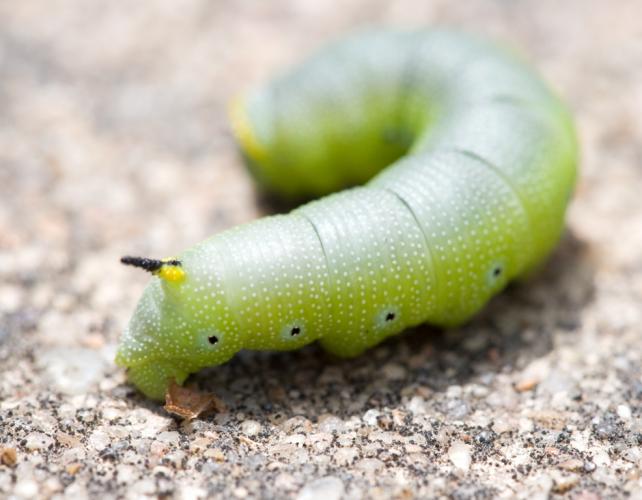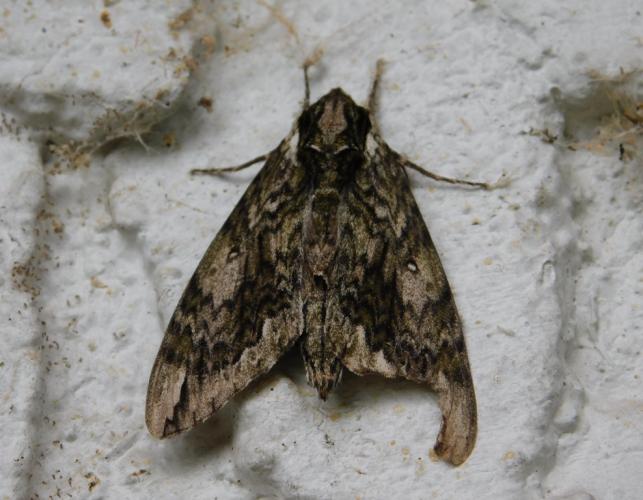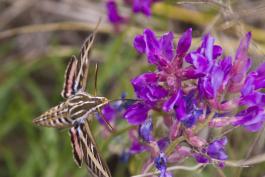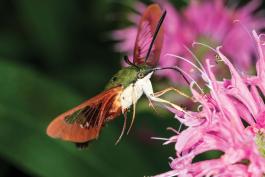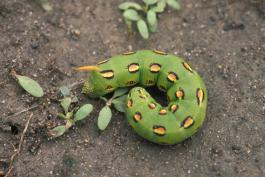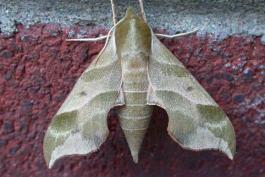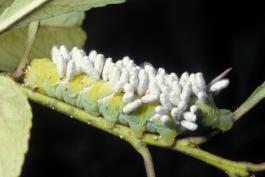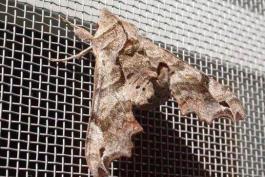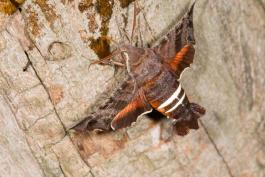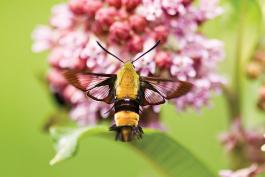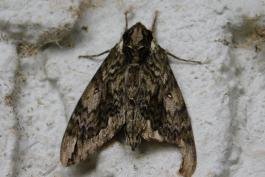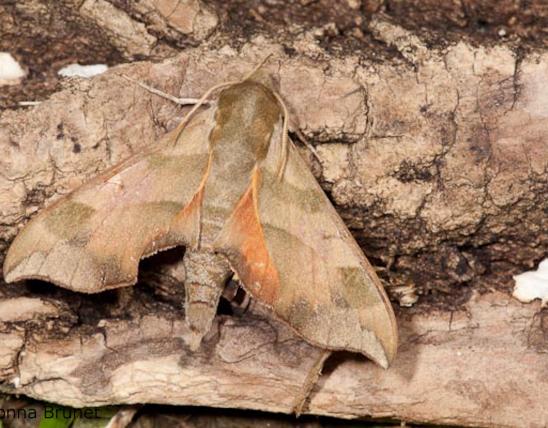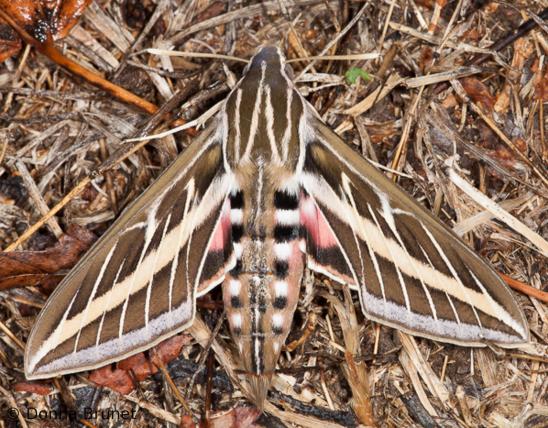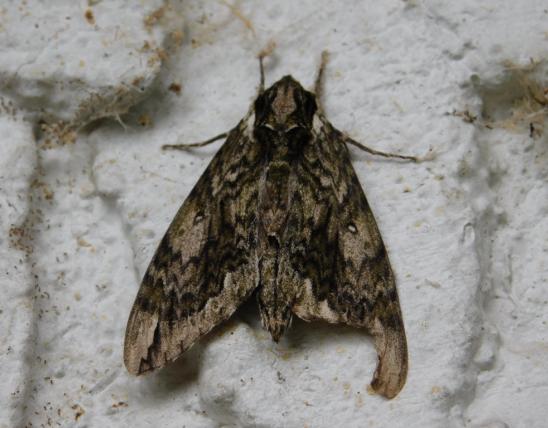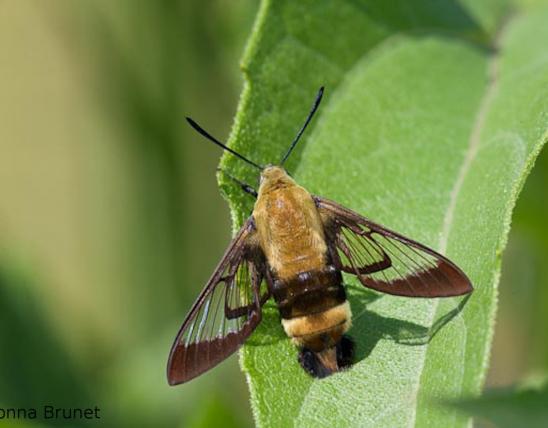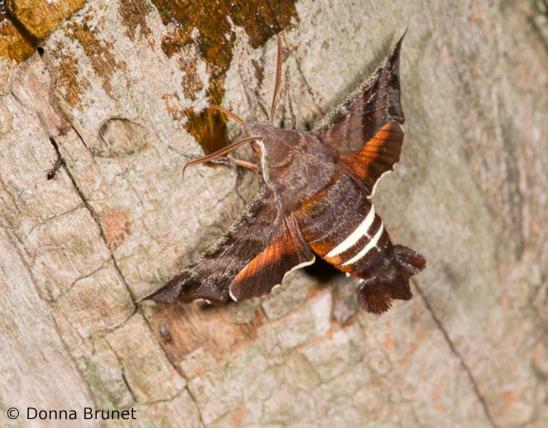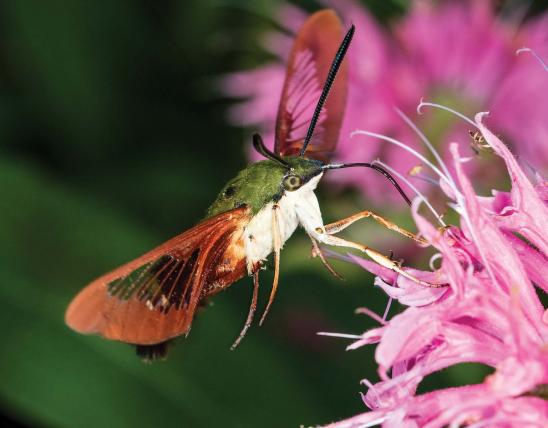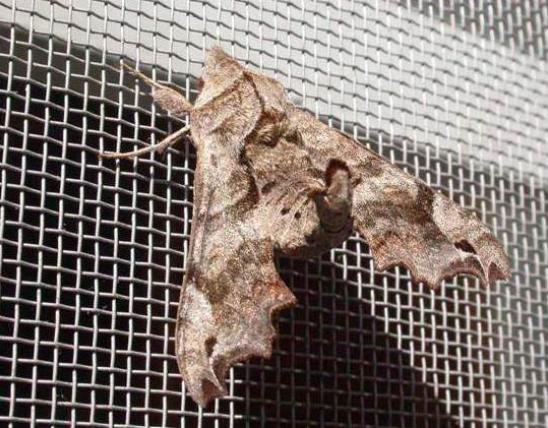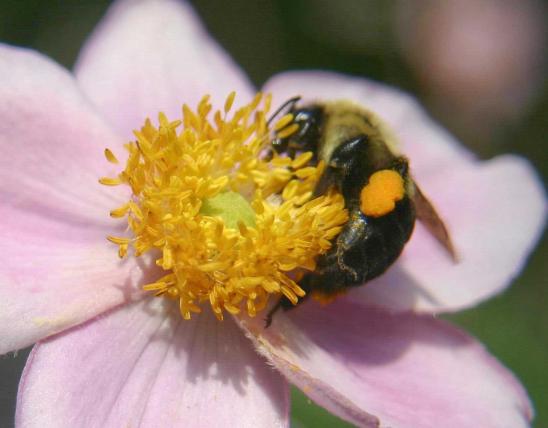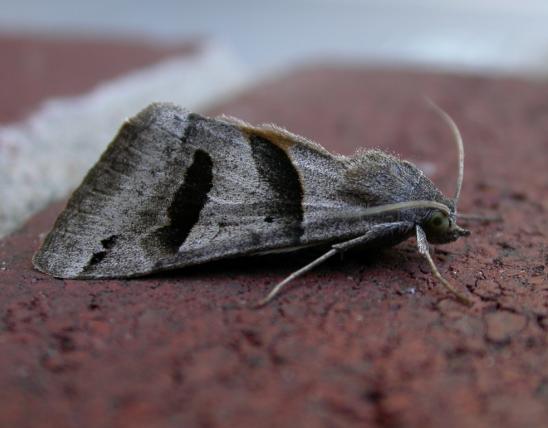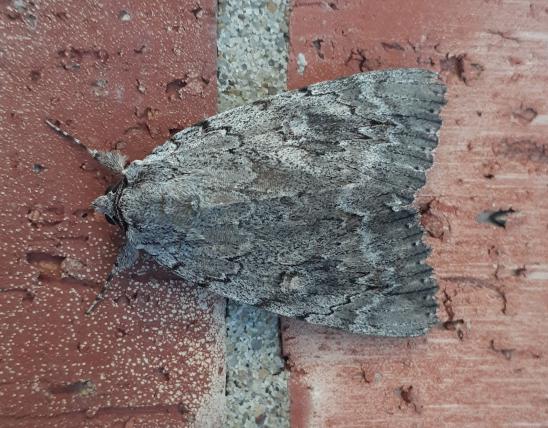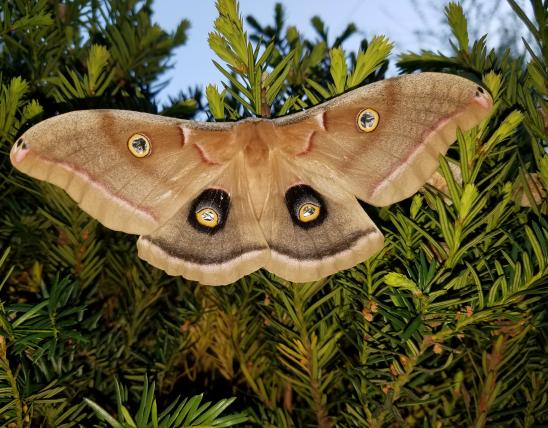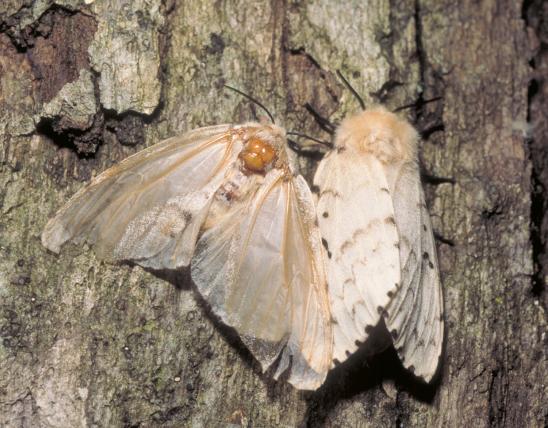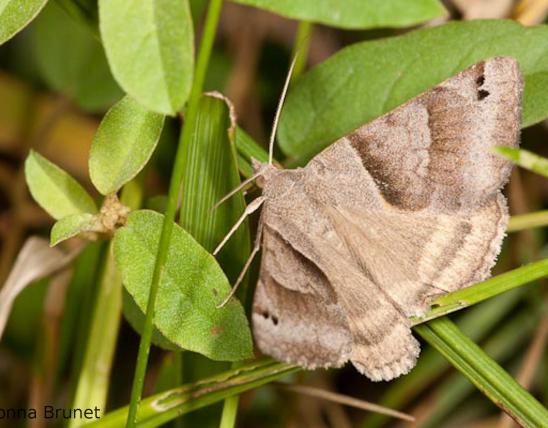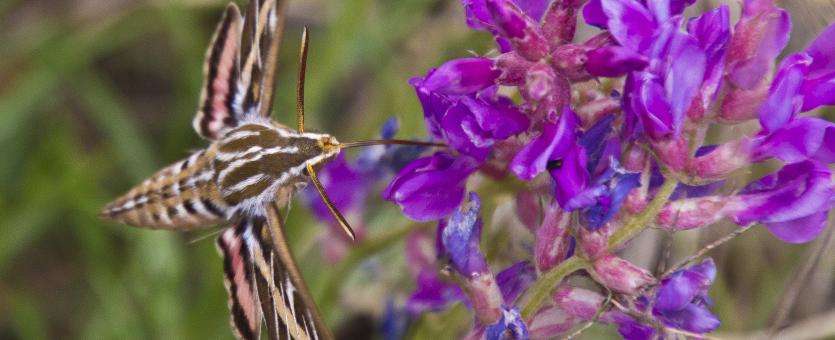
Sphinx moths are usually large and heavy bodied, with a long, pointed abdomen. They often hover near flowers, feeding on nectar via a very long proboscis (mouth tube or “tongue”). The forewings are generally long and pointed, although some species have angled or irregular margins. The antennae tend to get gradually wider, then narrow again toward the tip, and the comblike extensions (pectinations) of the antennae are usually short. Most sphinx moths are nocturnal, but some are most active at dawn and dusk, or during the day. The day-active species often mimic bees or hummingbirds.
Sphinx moth caterpillars are often called hornworms, because they usually have a stiff, pointy horn on the rear end. They often rest with the thorax raised into the air and the head tilted downward, which reminded people of the posture of sphinx statues from ancient Egypt and elsewhere.
Wingspan: 1¼ to 4¾ inches or more (varies with species).
Statewide. Different species are more common in different regions.
Habitat and Conservation
Like other moths, adult sphingids usually linger near their larval food plants, since the females must deposit eggs on or near those species, and males typically seek females near egg-laying locations. Also, when adult moths first emerge from their cocoons, they are usually near their food plants, where they had developed as caterpillars. So if you’re looking for, say, a modest sphinx, head to moist areas around lakes and river bottoms, where its willow, poplar, and cottonwood food plants abound.
Keep in mind that sphinx moths are strong fliers and can go almost anywhere. Many are attracted to lights at night. In the morning, you may find one or two resting on the side of your house where a light shined all night. You may also be able to tempt sphinx moths with a liquid sugar bait. They often visit flower gardens to take nectar.
Food
Sphinx moths use a wide range of larval host plants, including both woody and nonwoody species. Each moth species has its own suite of suitable host plants (for example, some eat only members of the tobacco/tomato/potato family; others must eat the leaves of rose-family trees such as plum, cherry, and apple). Many sphinx moth species are named for their notable food plants, such as the Osage orange sphinx, four-horned elm sphinx, wild cherry sphinx, walnut sphinx, big poplar sphinx, snowberry clearwing, and grapevine sphinx.
The caterpillars of some species are such well-known garden pests that they have their own names separate from that of the adult moth; prime examples are the tomato hornworm (five-spotted hawk moth) and the tobacco hornworm (Carolina sphinx).
Adult sphinx moths, with their long tongues, are experts at drinking nectar from long-throated flowers such as trumpet vine and jimsonweed. While feeding, they hover in the air like hummingbirds. Some are important pollinators. Different species take nectar during different times of day or night, and many at dusk or dawn.
Some of our sphinx moth species do not feed as adult moths.
Life Cycle
Most sphingids can produce several generations in a season, until cold weather stops them. Females attract males by emitting pheromones (courtship scents). Eggs are usually laid singly on suitable host plants. Mature caterpillars generally do not form cocoons but burrow into soil or leaf litter to pupate. A few species form a very thin cocoon on the surface of the ground. In a few weeks, they emerge from their pupae as adults. Most species overwinter in the pupal stage.
Human Connections
Planting large tube-shaped flowers can attract sphinx moths to your yard. In late summer, many people enjoy sitting on their patios and watching these mysterious hovering visitors sip nectar as twilight deepens.
Tomato and tobacco hornworms are the bane of people trying to grow tomato, potato, tobacco, pepper, and other plants in the nightshade family. Pink-spotted hawk moth caterpillars chew on sweet potato vines, and Pandora, Achemon, and Virginia creeper sphinx moth caterpillars are unwelcome in vineyards.
Although a few species are pests on garden plants, most sphinx moths do not cause significant injury to their host plants.
Though the hungry caterpillars can be vexing, you can’t help but be impressed by the elegant colors and patterns of the hefty, “furry” adult moths.
People are interested in the physics of sphinx moth flight, especially their ability to hover. Moths in this family are some of the fastest-flying insects, and they have several adaptations that make them good fliers: streamlined bodies, narrow wings with fore- and hindwings coupled together for efficiency, antennae that help them perform complex flying maneuvers, and a habit of “shivering” to warm up their flight muscles prior to taking off.
In the 1800s, Charles Darwin pondered the case of a rare orchid in Madagascar whose nectar was stored at the bottom of a foot-long flower tube. The naturalist who sent him a specimen asked, “Good Heavens what insect can suck it?” Darwin guessed there “must be moths with probosces capable of extension to a length of between 10 and 12 inches!” Alfred Russel Wallace concurred, suggesting it must be a kind of sphinx moth. A few decades later, the pollinator was indeed discovered, a sphinx moth with a tongue long enough to reach the nectar.
Ecosystem Connections
For many predators, sphinx moths are a nice meal, and the various camouflage patterns on the forewings remind us that avoiding detection is a first line of defense. Other defense mechanisms include larval food plants that are toxic; for example, the bitter chemicals in the foliage of nightshade plants, eaten by hornworms, renders the hornworms unpalatable to predators. Also, the caterpillars may regurgitate on attackers in an effort to fend off ants and parasitoids.
The caterpillar of the walnut sphinx has its own unique defense mechanism: when disturbed, it forces air out of its spiracles (the breathing holes along its side) to produce a whistling hiss. The Nessus sphinx caterpillar makes weird hissing and clicking noises by moving air back and forth past a constriction in its gut.
Some adult sphinx moths have black plus red, pink, orange, or yellow bands on their abdomen, which makes them look like bumblebees. The hummingbird and snowberry clearwings not only have fuzzy bumblebee-like bodies but also clear wings, that even fool people into thinking they belong to that group of stinging insects.
Predation comes in different forms. In addition to animals that capture and eat sphinx moths, small parasitoid braconid wasps inject their eggs (usually about 150 at a time) into the bodies of sphingid caterpillars. Within the caterpillar’s body, the grublike larval wasps eat the caterpillar’s hemolymph (blood), but they do not damage tissue (this is why the caterpillar continues to live “normally”). When the wasp larvae have grown enough, they emerge out of the “skin” of the caterpillar, spin cocoons, and pupate. It’s very common to see curious silky white oval blobs attached to the skin of hornworms — these are the cocoons of the pupating wasps. Once the wasps are pupating, the caterpillar stops eating. The wasp larvae ultimately kill the hornworm.
